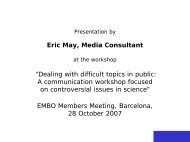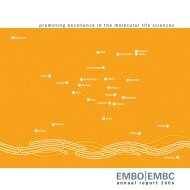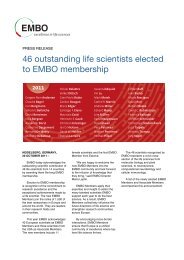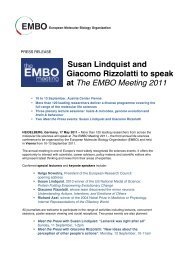EMBOencounters
EMBOencounters
EMBOencounters
You also want an ePaper? Increase the reach of your titles
YUMPU automatically turns print PDFs into web optimized ePapers that Google loves.
© Karlsruhe Institute of Technology (KIT) www.kit.edu The<br />
FEATURE<br />
stars of biomedicine<br />
Zebrafish are easy to breed, transparent and their eggs develop outside the body of the mother, allowing<br />
researchers to observe embryonic development without harming adult animals. Perhaps most importantly,<br />
many of their genes are identical to those of humans. This all makes the zebrafish, Danio rerio, an excellent<br />
model organism to better understand the molecular underpinnings of human diseases ranging from cancer<br />
to cardiovascular diseases, myopathy and neurodegenerative diseases.<br />
At the end of July, the biggest zebrafish<br />
repository in Europe was opened at the<br />
Karlsruhe Institute of Technology in<br />
southern germany. The European Zebrafish<br />
Resource Center (EZRC) maintains more than<br />
three thousand aquaria as well as freezers for<br />
50,000 sperm samples. EMBO Member Christiane<br />
Nüsslein-Volhard from the Max Planck Institute<br />
for Developmental Biology in Tübingen, germany<br />
talked about her pioneering role in European<br />
zebrafish research at the opening ceremony.<br />
“The idea of conducting research on vertebrates<br />
electrified me,” remembered Nüsslein-Volhard.<br />
Until the late eighties, she had focused on analysing<br />
the genetic control of embryo development in<br />
Drosophila. It was only after she had heard about<br />
the research results of United States scientist<br />
george Streisinger that she also started to work<br />
on vertebrates. Streisinger, who was a professor<br />
at the University of Oregon until his death in<br />
1984, is considered by many of his peers to be<br />
the founding father of zebrafish developmental<br />
and genetic research. “Our lab in Tübingen was<br />
among the first in Europe to work with zebrafish,”<br />
said the 1995 Nobel laureate.<br />
One of the problems her team faced was to<br />
breed fish families on a large scale. She knew<br />
from research on fruit flies that four to five thousand<br />
families are needed to identify the genes<br />
responsible for embryo development. Building a<br />
fish house for seven thousand aquaria in 1992<br />
improved the situation and Nüsslein-Volhard’s<br />
Aquaria<br />
group finished the screening of the mutants in<br />
only a few months. Then, her team submitted<br />
twenty-two manuscripts for a special issue of<br />
the journal Development – again, within a year.<br />
“That was a great time,” recalls the scientist.<br />
Wolfgang Driever, her former PhD student<br />
and now head of Developmental Biology at the<br />
University of Freiburg, explained in the next presentation<br />
why zebrafish are fascinating model<br />
organisms for neuroscientists. The striped fish<br />
have stunning regenerative skills. They are capable<br />
of developing dopaminergic neurons throughout<br />
their life – unlike humans. The loss of these<br />
neurons is irreversible in human organisms – and<br />
is responsible for neurological diseases such as<br />
Alzheimer’s.<br />
In recent years, European labs have generated<br />
thousands of zebrafish lines, each of which<br />
carries either a particular mutation that can<br />
serve as a model for a human disease. However,<br />
in contrast to their US colleagues, European<br />
researchers were lacking a central repository to<br />
store and distribute these fish. This role will be<br />
assumed by the EZRC in future. The institute<br />
will also function as the first zebrafish screening<br />
centre worldwide, welcoming guest researchers<br />
from all over the globe to perform systematic<br />
research on these vertebrates. The Karlsruhe<br />
Institute of Technology is an ideal location for<br />
such a centre as it offers a unique interdisciplinary<br />
environment combining top research in<br />
natural and engineering sciences.<br />
Top: The zebrafish Danio rerio<br />
High throughput laboratory facility<br />
8 <strong>EMBOencounters</strong> | Autumn 2012 | communications@embo.org<br />
©2012 EMBO
















